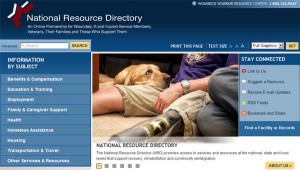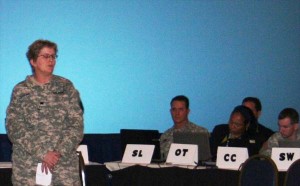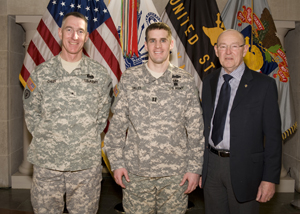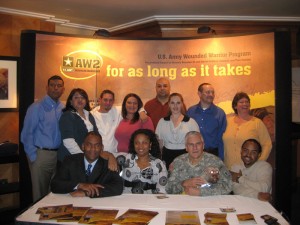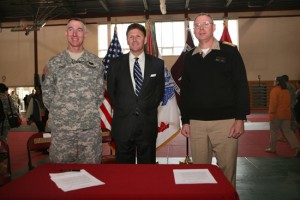
Brig. Gen. Gary Cheek (left) with Assistant Secretary of the Navy for Manpower and Reserve Affairs Juan Garcia (center) and Vice Adm. Kevin McCoy (right) after signing a memorandum of agreement to increase employment opportunities for wounded warriors.
(Cross-posted from NAVSEA’s Web site)
Due to advances in modern military medicine, unprecedented numbers of wounded service members are returning to the fight or transitioning their service to civilian employment.
Vice Adm. Kevin McCoy, commander, Naval Sea Systems Command (NAVSEA) and Army Brig. Gen. Gary Cheek, commanding general, U.S. Army’s Warrior Transition Command (WTC) signed a memorandum of agreement (MoA) Jan. 13 in Walter Reed Army Medical Center’s Wagner Gym auditorium to increase opportunities for meaningful internships and/or employment with the Navy’s largest system command.
“What we have done so far is put the fundamentals in place. But our real goal is to provide that opportunity, that light, that inspiration for a full and productive future to the warfighters in this program,” Cheek told those assembled. “No matter what disease, illness or injury you are fighting, you have skills and abilities that make a difference in this world.”
The general continued by focusing on the scope of opportunities the program’s partnership with NAVSEA offers wounded warriors. “Of all the organizations we are starting to embrace and work with, I believe NAVSEA is perhaps one of the finest in what they are offering to provide for the future for many of you. There are opportunities within this command across the United States, possibly even in your hometown, doing things you would like to do and making a contribution to the nation,” he said.
Following the general’s remarks, McCoy thanked the injured service members for their service, and committed his organization to increasing opportunities for them.
“We are a workforce of about 60,000, 95 percent of which are civilian employees – about one-third of all Navy civilians work for NAVSEA,” said McCoy. “We provide ship, submarines, aircraft carriers, weapons systems to our warfighters. We’re responsible for all the maintenance on our surface ships, subs and aircraft carriers. ”
McCoy continued to promote the significance of the command’s numerous and diverse career opportunities, including his own personal passion for work done at the Navy’s shipyards.
“Half of NAVSEA carries a lunch bucket, wears a hard hat and steel-toe shoes to work each day. In my opinion, we have the best blue collar jobs in America – jobs you can raise a family on,” said McCoy. “The entry requirement to be an electrician, pipe-fitter, welder, technician, is a high-school degree and lots of enthusiam. We will give you everything else. We have stable careers working on some of our nation’s most important military war platforms.”
The MoA signed between NAVSEA and WTC establishes roles and responsibilities for the coordination of Operation Warfighter internships available to service members receiving medical treatment for combat-related injuries, as well as permanent employment opportunities for warriors in transition, Army Wounded Warrior (AW2) veterans, and their spouses/caregivers, as eligible for various federal direct-hiring authorities.
Juan Garcia, Assistant Secretary of the Navy for Manpower and Reserve Affairs also lauded NAVSEA’s contributions towards warrior transition efforts, and reminded assembled troops that employers are eager to put their skills, knowledge and determination to use.
“This is not charity. This is not a ‘set-aside’ program,” said Garcia. “Wounded warriors are, by definition, tenacious and resilient. They are leaders and doers. At a very young age, they have proven themselves capable of accomplishing what has been set before them.”
“In the Department of the Navy, NAVSEA has set the pace and created the model for wounded warrior integrations. They have made a commitment. They have put their money where their mouth is, and they have brought accountability to the process,” Garcia continued.
The signing of this MoA reflects the commitment between NAVSEA and WTC to provide the best possible care and future opportunities to our nation’s combat-wounded service members, veterans and their families.
For Wounded Warriors interested in employment opportunities at NAVSEA and Navy commands interested in supporting Wounded Warriors, contact Cmdr. David McAfee at david.r.mcafee@navy.mil or (202)781-1364.
